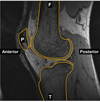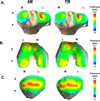Diurnal variations in articular cartilage thickness and strain in the human knee
- PMID: 23102493
- PMCID: PMC3552039
- DOI: 10.1016/j.jbiomech.2012.09.013
Diurnal variations in articular cartilage thickness and strain in the human knee
Abstract
Due to the biphasic viscoelastic nature of cartilage, joint loading may result in deformations that require times on the order of hours to fully recover. Thus, cartilaginous tissues may exhibit cumulative strain over the course of each day. The goal of this study was to assess the magnitude and spatial distribution of strain in the articular cartilage of the knee with daily activity. Magnetic resonance (MR) images of 10 asymptomatic subjects (six males and four females) with mean age of 29 years were obtained at 8:00 AM and 4:00 PM on the same day using a 3T magnet. These images were used to create 3D models of the femur, tibia, and patella from which cartilage thickness distributions were quantified. Cartilage thickness generally decreased from AM to PM in all areas except the patellofemoral groove and was associated with significant compressive strains in the medial condyle and tibial plateau. From AM to PM, cartilage of the medial tibial plateau exhibited a compressive strain of -5.1±1.0% (mean±SEM) averaged over all locations, while strains in the lateral plateau were slightly lower (-3.1±0.6%). Femoral cartilage showed an average strain of -1.9±0.6%. The findings of this study show that human knee cartilage undergoes diurnal changes in strain that vary with site in the joint. Since abnormal joint loading can be detrimental to cartilage homeostasis, these data provide a baseline for future studies investigating the effects of altered biomechanics on diurnal cartilage strains and cartilage physiology.
Copyright © 2012 Elsevier Ltd. All rights reserved.
Conflict of interest statement
Figures






Similar articles
-
In vivo measurement of localized tibiofemoral cartilage strains in response to dynamic activity.Am J Sports Med. 2015 Feb;43(2):370-6. doi: 10.1177/0363546514559821. Epub 2014 Dec 10. Am J Sports Med. 2015. PMID: 25504809 Free PMC article.
-
High body mass index is associated with increased diurnal strains in the articular cartilage of the knee.Arthritis Rheum. 2013 Oct;65(10):2615-22. doi: 10.1002/art.38062. Arthritis Rheum. 2013. PMID: 23818303 Free PMC article.
-
Knee Cartilage Thickness, T1ρ and T2 Relaxation Time Are Related to Articular Cartilage Loading in Healthy Adults.PLoS One. 2017 Jan 11;12(1):e0170002. doi: 10.1371/journal.pone.0170002. eCollection 2017. PLoS One. 2017. PMID: 28076431 Free PMC article.
-
In vivo morphometry and functional analysis of human articular cartilage with quantitative magnetic resonance imaging--from image to data, from data to theory.Anat Embryol (Berl). 2001 Mar;203(3):147-73. doi: 10.1007/s004290000154. Anat Embryol (Berl). 2001. PMID: 11303902 Review.
-
Bony and cartilaginous anatomy of the patellofemoral joint.Knee Surg Sports Traumatol Arthrosc. 2006 Mar;14(3):235-40. doi: 10.1007/s00167-005-0683-0. Epub 2005 Oct 28. Knee Surg Sports Traumatol Arthrosc. 2006. PMID: 16254736 Review.
Cited by
-
Determination of the Position of the Knee at the Time of an Anterior Cruciate Ligament Rupture for Male Versus Female Patients by an Analysis of Bone Bruises.Am J Sports Med. 2018 Jun;46(7):1559-1565. doi: 10.1177/0363546518764681. Epub 2018 Apr 18. Am J Sports Med. 2018. PMID: 29667852 Free PMC article.
-
The mechanobiology of articular cartilage: bearing the burden of osteoarthritis.Curr Rheumatol Rep. 2014 Oct;16(10):451. doi: 10.1007/s11926-014-0451-6. Curr Rheumatol Rep. 2014. PMID: 25182679 Free PMC article. Review.
-
In vivo measurement of localized tibiofemoral cartilage strains in response to dynamic activity.Am J Sports Med. 2015 Feb;43(2):370-6. doi: 10.1177/0363546514559821. Epub 2014 Dec 10. Am J Sports Med. 2015. PMID: 25504809 Free PMC article.
-
Effects of ACL graft placement on in vivo knee function and cartilage thickness distributions.J Orthop Res. 2017 Jun;35(6):1160-1170. doi: 10.1002/jor.23541. Epub 2017 Mar 24. J Orthop Res. 2017. PMID: 28213953 Free PMC article. Review.
-
Influence of the Mechanical Environment on the Regeneration of Osteochondral Defects.Front Bioeng Biotechnol. 2021 Jan 27;9:603408. doi: 10.3389/fbioe.2021.603408. eCollection 2021. Front Bioeng Biotechnol. 2021. PMID: 33585430 Free PMC article. Review.
References
-
- Aaboe J, Bliddal H, Messier SP, Alkjaer T, Henriksen M. Effects of an intensive weight loss program on knee joint loading in obese adults with knee osteoarthritis. Osteoarthritis and cartilage / OARS, Osteoarthritis Research Society. 2011;19:822–828. - PubMed
-
- Abebe ES, Moorman CT, 3rd, Dziedzic TS, Spritzer CE, Cothran RL, Taylor DC, Garrett WE, Jr, DeFrate LE. Femoral tunnel placement during anterior cruciate ligament reconstruction: an in vivo imaging analysis comparing transtibial and 2-incision tibial tunnel-independent techniques. Am J Sports Med. 2009;37:1904–1911. - PubMed
-
- Anandacoomarasamy A, Leibman S, Smith G, Caterson I, Giuffre B, Fransen M, Sambrook PN, March L. Weight loss in obese people has structure-modifying effects on medial but not on lateral knee articular cartilage. Annals of the rheumatic diseases. 2012;71:26–32. - PubMed
-
- Andriacchi TP, Lang PL, Alexander EJ, Hurwitz DE. Methods for evaluating the progression of osteoarthritis. J Rehabil Res Dev. 2000;37:163–170. - PubMed
-
- Andriacchi TP, Mundermann A, Smith RL, Alexander EJ, Dyrby CO, Koo S. A framework for the in vivo pathomechanics of osteoarthritis at the knee. Annals of biomedical engineering. 2004;32:447–457. - PubMed
Publication types
MeSH terms
Grants and funding
LinkOut - more resources
Full Text Sources
Other Literature Sources

